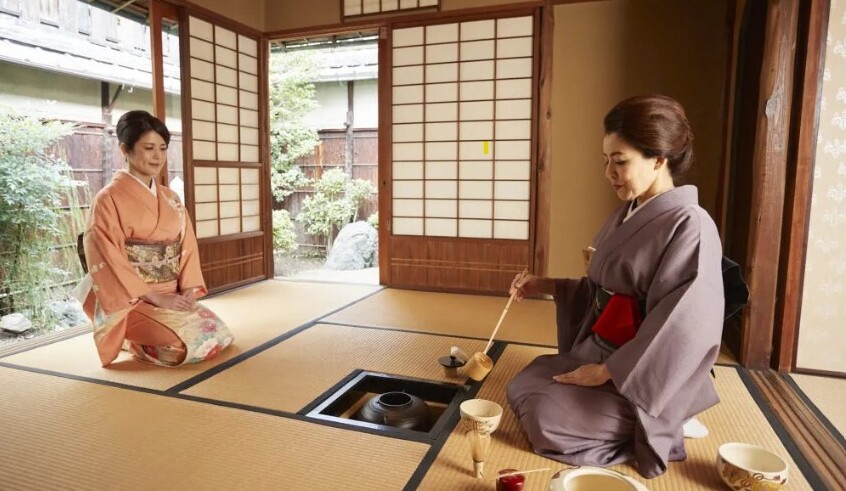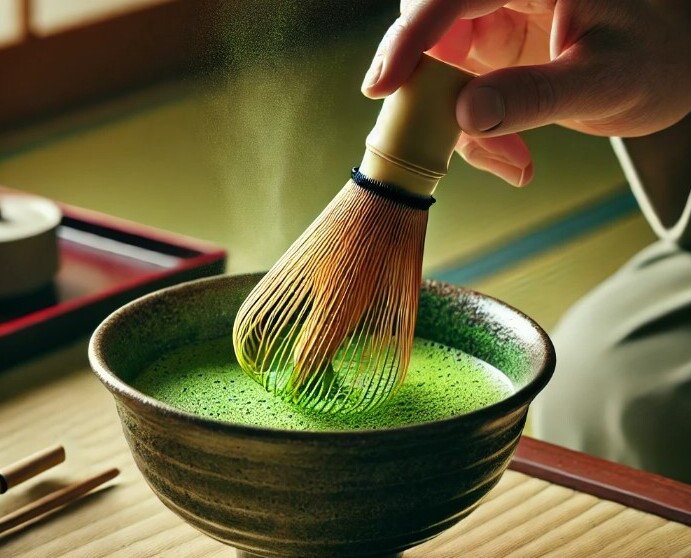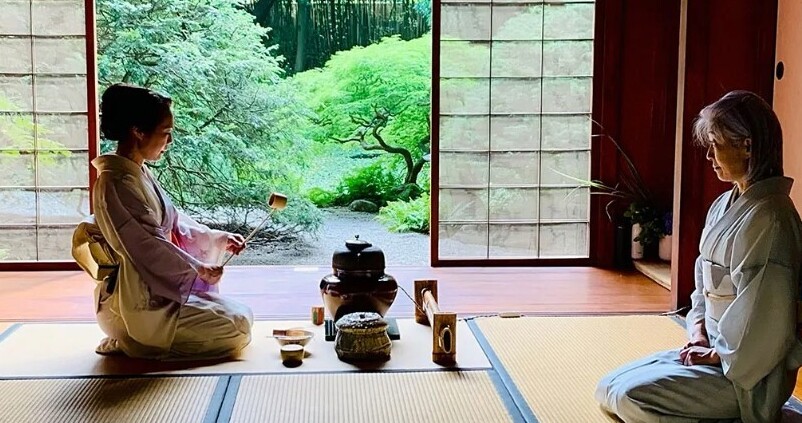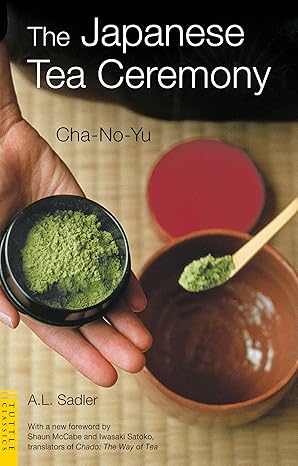
Japanese tea ceremonies, often referred to as ‘Chanoyu’ or ‘Sado,’ offer a fascinating glimpse into the cultural tapestry of Japan. These aren’t your average tea gatherings but are rich in history and laden with meaning. Introduced in the 9th century, the practice has evolved yet kept its roots firmly planted in tradition.
At the core of these ceremonies is a focus on appreciation and mindfulness. They’re a spiritual journey, not just a cup of tea. Each movement, each gesture, plays a role in this intricate dance. It’s about creating a moment, a pause in our bustling lives, where simplicity and tranquility prevail.
The importance of these ceremonies extends beyond just drinking tea. With the use of specific tools like the ‘Chasen’ (bamboo whisk) and ‘Chawan’ (tea bowl), every element has its place and purpose. Even the sound of water pouring or the sight of the tea being whisked holds symbolic weight.
As they evolved, these tea gatherings began to reflect the ideals of Zen Buddhism, embedding values like harmony, respect, purity, and tranquility. It’s a meditative experience meant to heighten one’s senses and cultivate a mindful existence. All this makes the Japanese tea ceremony much more than an ancient tradition; it’s an art form in itself.
The Sacred Role of Green Tea: From Leaf to Cup
Green tea is the star performer in Japanese tea ceremonies, with Matcha taking the spotlight. Unlike your run-of-the-mill tea bags, Matcha is a finely milled powder of specially grown green tea leaves, known for its rich, vibrant flavor and frothy texture.
Preparing green tea for a ceremony isn’t like your quick morning brew. The leaves are shaded from sunlight for about three weeks before harvesting, which boosts their chlorophyll levels and amino acids, leading to that striking green hue and complex flavor profile.
To get Matcha ready for its ceremonial debut, it’s meticulously stone-ground, creating a delicate powder. The grinding process can be slow and careful, sometimes taking an hour to produce just one ounce of Matcha. This dedication underlines the importance placed on quality and tradition.
Engaging all the senses, the experience of brewing and enjoying Matcha is both artistic and mindful. It starts with admiring the powder’s vibrant color, followed by the aroma released as hot water mingles with the tea. Mixing it with a bamboo whisk isn’t just for show – it’s about achieving a perfectly frothy texture.
When you finally take a sip, you’re met with an umami-rich taste that is both earthy and sweet. It’s this sensory journey that makes green tea more than just a drink; it becomes a sensory meditation, enveloping you in the present moment.

Types of Japanese Tea Ceremonies
There isn’t just one kind of Japanese tea ceremony; they come in different forms depending on the setting, formality, and occasion. The two main types are:
- Chaji: A formal, multi-course tea gathering that can last up to four hours. It involves a meal (kaiseki), thick tea (koicha), and thin tea (usucha).
- Chakai: A more casual gathering that lasts a shorter time and focuses primarily on the enjoyment of tea and sweets.
Steps of the Tea Ceremony And Role Of The Tea Masters
A traditional Japanese tea ceremony follows a structured process, with each step carried out with precision and grace. At the heart of this ritual is the tea master (Chajin), whose years of training transform a simple act of making tea into an art form. Trained under tea schools such as Urasenke, Omotesenke, or Mushakouji-senke, these masters embody the philosophy and etiquette of the ceremony, ensuring every movement is intentional and meaningful.
Though variations exist, the core steps of a tea ceremony include:
- Purification: Guests wash their hands and rinse their mouths as a symbolic gesture of cleansing before entering the tea room.
- Entering the tea room: Guests bow as they step inside, appreciating the minimalist beauty of the setting.
- Serving of sweets: Traditional Japanese sweets (wagashi) are offered before the tea to balance Matcha’s natural bitterness.
- Preparation of tea: The tea master skillfully prepares the tea using precise, flowing movements, embodying discipline and mindfulness. They carefully measure the Matcha, whisk it to a frothy consistency with a bamboo whisk (Chasen), and ensure every detail adheres to tradition.
- Drinking the tea: Guests admire the tea, rotate the bowl slightly, and take small sips, savoring the rich umami flavors.
- Expressing gratitude: Guests thank the host for the experience, recognizing the effort and philosophy behind the ceremony.
Tea masters don’t just brew tea; they curate an experience that engages all the senses. Their expertise extends beyond the ceremony itself, as they study calligraphy, flower arranging, and the deeper meanings of wabi-sabi (the beauty of imperfection). This dedication ensures that every tea gathering remains a meditative, transformative event.

How to Experience A Traditional Tea Ceremony
If you’re intrigued by the art of Japanese tea ceremonies, you may wonder how to experience one for yourself. In Japan, traditional tea houses (chashitsu) offer immersive experiences where guests can participate under the guidance of a tea master. Many temples and cultural centers also host public ceremonies, making it accessible even for travelers. Outside Japan, cultural institutions, Japanese gardens, and tea schools provide workshops and demonstrations, bringing the tradition to global audiences.
Cultural and Philosophical Dimensions of Green Tea
In the world of Japanese tea ceremonies, each aspect is steeped in symbolism and philosophy. The tea ceremony is an art that goes beyond taste – it’s about cultivating a greater understanding of beauty, simplicity, and tranquility.
Drawing from Zen Buddhism, tea ceremonies emphasize concepts like ‘wabi-sabi,’ which celebrates imperfections and the transient nature of life. In a world chasing perfection, this embrace of simplicity and authenticity provides a refreshing perspective.
The values manifested in tea ceremonies align closely with Zen teachings. It’s an opportunity to practice mindfulness and live in the moment, promoting self-awareness and inner peace. The ceremony becomes a moving meditation, encouraging participants to focus, breathe, and appreciate.
The environment plays a role too, with tea rooms often being sparsely decorated, echoing the minimalist aesthetic that encourages reflection. Even the tea utensils, varying subtly in color, texture, and form, embody these philosophies, with their uniqueness celebrated rather than critiqued.
The whole ceremony is a powerful reminder to find beauty and meaning in everyday life. By slowing down and prioritizing these seemingly simple rituals, practitioners rediscover the magic in the mundane, learning to cherish life’s fleeting moments.
Health Implications: Green Tea Beyond Tradition
The Japanese tea ceremony is more than a ritual—it is a practice of mindfulness, encouraging participants to slow down, focus on the present, and cultivate inner peace. This meditative approach to tea drinking aligns closely with Zen principles, reinforcing a sense of balance and well-being. But beyond its spiritual and philosophical significance, green tea itself carries profound health benefits that have been recognized for centuries.
Rich in antioxidants like catechins, Matcha is celebrated for its ability to boost metabolism, enhance cognitive function, and reduce the risk of heart disease. Scientific studies continue to uncover its role in promoting longevity and overall wellness. The act of preparing and drinking tea in a mindful setting further amplifies these benefits, reducing stress and fostering mental clarity.
In today’s fast-paced world, more people are integrating these principles into their daily lives. Whether through tea rituals, mindfulness workshops, or wellness practices, the tea ceremony offers a holistic approach to health—nurturing both the body and the mind.
Green Tea in Modern-Day Japan: Preserving Tradition in a Fast-Paced World
In contemporary Japan, where life moves at a rapid clip, the tea ceremony remains a cherished practice, albeit with some modern twists. Amid Japan’s famously hectic work culture, these ceremonies offer a rare pause, a moment to reconnect with deeper values. They’re evolving, though, as more people seek simpler ceremonies to fit into busier schedules.
This evolution doesn’t mean losing sight of traditions. Various initiatives strive to keep tea rituals alive, especially among the younger crowd who might see these customs as old-school. Workshops and modern tea gatherings are sprouting up, making these age-old practices accessible and relevant to a new generation.
With global interest in wellness on the rise, international fascination with Japanese tea ceremonies is growing too. Beyond Japan’s borders, adaptations of these ceremonies are popping up, balancing tradition with cultural nuances. These efforts not only preserve the ritual’s core values but also offer fresh interpretations that resonate with diverse audiences.
Japanese tea ceremonies, defined by their serene precision and artistry, continue to be a cultural mainstay in a world that’s constantly changing. They remind us that even in fast-paced modern life, there’s always room for reflection, appreciation, and tranquility. As more people embrace this mindful ritual, green tea steadily weaves its way into the fabric of daily life, proving it’s here to stay.
Can You Host a Tea Ceremony At Home
Absolutely! While mastering the full art of Chanoyu takes years of study, you can bring elements of the ceremony into your own space. Start with a quiet, uncluttered setting, use authentic tea-making tools, and focus on the mindful preparation of Matcha. The key isn’t perfection but embracing the philosophy of being present and appreciating the moment.
Savoring the Moment: The Heart of Japanese Tea
At the end of the day, the Japanese tea ceremony isn’t just about tea—it’s about slowing down, appreciating the moment, and finding beauty in simplicity. In a world that’s always rushing forward, this ritual reminds us to pause, breathe, and be present. Whether you’re sipping Matcha in a traditional tea house or whisking up a bowl in your own kitchen, the essence remains the same: it’s not just a drink, it’s an experience. And maybe, that’s exactly what we need more of.
📖 Book Tip!
If you’d like to explore the art and philosophy of Japanese tea ceremonies further, I highly recommend The Japanese Tea Ceremony: Cha-No-Yu. This classic book delves into the history, rituals, and significance of this beautiful tradition.

This post contains affiliate links. If you make a purchase through these links, I may earn a commission at no extra cost to you.
